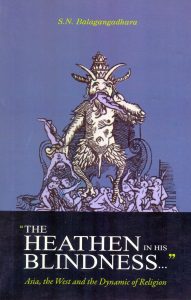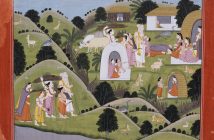Dharma is an age old tradition with an unmistaken element of diversity unlike any other ancient or modern civilisation. Quintessentially, dharma is the scientific investigation of human psyche by human beings for human beings. While dharma is experiential, the doctrines associated with dharma can be marked by the explicit focus on Satya and Ahimsa.
Mistranslation of Dharma as Religion
Often dharma is translated as religion in the absence of a proper synonym in English. This has been challenged by many scholars. Prof. S.N. Balagangadhara, an insider to the western academia, pointed out this “non-religious” construct of the Dharma tradition. In his book “The Heathen in His Blindness”: Asia, the West and the Dynamic of Religion (1994) he presented his thesis that demarcates the Indic tradition from the Abrahamic tradition. This scholarly and rigorous book is well-acclaimed. Balagangadhara is, currently the director of the India Platform and the Research Centre Vergelijkende Cutuurwetenschap (Comparative Science of Cultures) at the Ghent University, Belgium.
In the preface of this book, Balagangadhara clarifies that appreciation of his thesis demands from the reader—either the Western one or the colonised elite of a non-western nation—a dissociation from her/his cultural background who, knowingly or unknowingly, grew up under the influence of a Christianity induced culture. Therefore, his book presents the arguments keeping the cultural background of the potential readers in mind.

The book, rather unconventionally, addresses the reader in the second person to emphasise the non-universal nature of any culture-based dialogue and non-translatability of culture-based words. It is perfectly possible to translate a sentence like “It rains” or “It is sunny” in all languages of the world of all times, since all cultures have witnessed the rain and the sun in their experience. In the cultural sphere, experiences of different groups are quite different, and therefore, one set of cultural constructs may not be translated into another language. What is more significant is that this mistranslation of initial set of cultural constructs may prepare ground for further and more serious misunderstandings.
Let us do a thought experience to illustrate this idea through an example in the physical sphere. If any of us lands up in a stone-age world, we will not have any difficulty to translate the physical phenomena like the sun or the rain of that world. However, if we teleport a stone age person to any of our modern cities, he will be short of his vocabulary while viewing the modern technological marvels like electricity that allows the modern citizens to switch on a light by pressing a button far away. The wonderstruck stone-age-person may call electricity as ‘magic’ for want of experience. He may incorrectly presume all citizens as magicians and may attribute imaginary attributes to these “magicians”.
Although only a thought experiment, it presents an analogy to the prevailing cultural situation. A spiritually advanced diverse culture like India (the modern day citizen) can readily understand the monolithic constructs of another society (the stone-age person) but the gaze reversal causes umpteen misconceptions. Therefore, the Western academy presents Buddha as a rebel to Hinduism (the alternative terminology used is Brahmanism) and considers him to be the founder of a new religion that is antithetical to Brahmanism. This western understanding seems quite ridiculous to the Dharma tradition for the following reason.
![]()
The Western academy conceives Buddha antithetical to Brahmanism like Marx is anti-Capitalism. Could Marx ponder over the question as to who is a “true” capitalist and attribute all noble Marxian qualities to a “true” capitalist? The answer, would be, an unequivocal No! Buddha, the so-called “anti-brahmin”, inexplicably for a western scholar, did define a “true” brahmin in several places (For example Dhammapada 417, 81 quoted in The Heathen in His Blindness page 208) and the “true” Brahman defined by Buddha is the most honourable person, says Buddha. This is a paradox that is beyond the western scholars to resolve.
A dharma-practitioner sees no contradiction in this phenomenon. To him, Buddha presented his realised idea that meditation is more conducive to peace than yajna with animal sacrifice. There are others like Vasu, the King of Chedi, who also opined the redundancy of animal sacrifice; he is also respected in the rituals of so-called Brahmanism.[i] A true brahmin—that is, a knowledge seeker, as commonly understood in the Dharma tradition—definitely knows the means to peace and would be most honourable to Buddha.
The conclusion of Balagangadhara is plain and simple: Indian society is marked by absence of religion.
What is Religion?
Religion is defined, in the Oxford dictionary, as the belief in and worship of a superhuman controlling power. It is a cosmology, some kind of theory about human destiny.
Religions require Faith unlike dharma which is scientific exploration of human psyche. To a scientific practitioner of Dharma, this difference is crystal clear. This difference—however—cannot be even recognised by those who do not undertake dharma-practises. Those who practise dharma rituals without the scientific attitude, may also find both dharma and religion as a matter of faith. Giants in the tradition of dharma, suggested rules for socio-political discourse and development of personal consciousness, based on their own experience which is potentially verifiable by all. In religious traditions too, the Prophets shared their commandments to their followers who must follow them for rich after-life benefits. Differentiation between these two sets of rules may be confusing for many.
What Differentiates Dharma from a Religion
If religion is simply a faith, many sects of the dharma tradition may be called faiths too. Any doctrine under the dharma tradition, however, must adhere to satya and ahimsa, which is not a requirement for a religion. In the Indic tradition, doctrines are of two kinds: dharma and adharma[ii] where the latter do not subscribe to satya and ahimsa.
An Analogy on Dharma and Religion
Analogies are seldom perfect, yet I tread the risky path for a better understanding. A Dharma-theory may tell us, if we do not add water to the car-radiator, the car-engine may suffer on account of overheating. A Religion-theory, on the contrary, will be: if we do not keep the photo of Vishvakarman—the devata of engineering—beneath the windscreen, we will end up hurting the car-engine. To an unintelligent person, a false equivalence may arise between the two theories, as both suggest about following a rule and imply disastrous consequences of not following the rule.
Truth and Ahimsa: The Touchstone
Now, which of these two theoreticians will be more secured? Which of them will be more prone to violence? If I do not want to add water to my car-radiator, Dharma-theoretician would perhaps smile at me and retort to me, “Yes go ahead; examine my words”. He will not be perturbed by my lack of faith and is least likely to throw any violence. On being told about my reluctance to hold the photo of Vishvakarman, the Religion-theoretician would, unlike Dharma-theoretician, be prone to—directly or indirectly—blaming me for my lack of faith in Vishvakarman, which is initiation of violence in the subtlest form.
In essence, ahimsa is an action-policy emanating out of satya. Therefore, satya can be verified from the practise of ahimsa, and ahimsa is reinforced from a true understanding of the universe, satya. They are complementary and supplementary to each other. Without pursuit of satya, one cannot practise ahimsa for long. For a satya-less doctrine, the inquisitive minds are to be silenced using some kind of himsa. On the other hand, without practice of ahimsa, the pursuit of satya is impossible. The course correction to reality will be blocked by easy choice to mute the critics through himsa. Consequently, satya may be subjugated to human greed and personal ambition.
Divergent Action-Policy by Dharma and Religion
While in verbose theory-making, one can term one’s own religion with grandiose adjectives like religion of peace, religion of love etc., the real examination of its type—dharma or adharma—can be done by analysing the action-policy. If the action-policies of any religion do not adequately emphasise satya and ahimsa, it is not dharma.
Satya is reality. Analysis of reality requires complete freedom of expression and thought to all. A dharma-based policy will neither take away one’s personal freedom to thought and expression nor will stifle criticism in any form. A dharma tradition will never be interested in book-burning or book-banning but in comparative analysis of various truth claims. On the other hand, a faith based religion is never interested in real debates but stifles others’ right to criticism whenever possible.
In ancient India, Charvaka who was grossly opposed to the fundamentals of the Dharma tradition, was allowed to express his thoughts. Buddha who pointed out insignificance of many rituals practised by Indians of those times, preached his idea to dharma-practitioners without any threat. Such respect for satya is not observed in the present day secular India where criticism of a religion is virtually banned under the Indian Penal Code article 295.[iii]
Furthermore, dharma can never suggest any physical, mental, cultural, emotional aggression against “the Others”, in its pursuit of ahimsa. Anybody, in the light of this divergent course of action policy, can judge what is dharma and what is an adharma-based religion. Any sect in the dharma tradition must emphasise a single policy for the entire humanity whereas many a religion divides the humanity among believers and the non-believers. Here such a religion commits the primal act of violence.[iv]
Dharma’s View of Religion
Religions may or may not have originated from a Dharma-tradition; they may or may not have scientific roots. In case a religion can trace its origin to a dharma tradition and its rules resonate laws derived in first-person-empiricism based science, we can think about this religion as one that inherits some aspects of dharma. For those who are comfortable with the parlance of Marxian sociology, the science of dharma is the base, on which the superstructure of this particular religion is founded.
For example, Hinduism—a so-called religion of the present times—is founded upon the science of dharma. One should not, nevertheless, prone to a conclusion that every aspect of Hinduism reflects the science of dharma. The science of dharma, as argued in this article, is the highest expression of human consciousness and time to time, adherents of the dharma-tradition deviated from that stage of the highest consciousness. Such deviations produced outgrowths that are, no way, expressions of the science of dharma.
In the words of David Frawley, there are more religions inside of Hinduism than outside of it. This is indicative of two things. One, satya and ahimsa allows sustained harmony among sects inspite of diverse outlooks. Second, without explicit focus on satya and ahimsa, harmonious existence and cultivation of diversity is impossible.
“Sarva Dharma Sama Bhava”
This is a well-articulated phrase in contemporary Hinduism which often passes off as its essence.[v] This phrase is a tautology if it is taken in its true meaning. “All dharmas are of the same inclination”. Indeed all different doctrines or facets of dharma, by definition, must cater to the twin theme of satya and ahimsa.
Yet, the popular meaning of this phrase is “equivalence (equality) of all religions” which is quite nonsensical. The Abrahamic religions whose cosmology describes one finite human life and an infinite afterlife of Hell or Heaven depending on faith in a particular Prophet, is no way equivalent, similar or even comparable to the Dharma tradition cosmology that describes reincarnation till absoluteness is achieved.[vi] They are simply different, as Rajiv Malhotra has convincingly demonstrated in his book Being Different (2011). The fact that the nonsensical meaning of this phrase has become a main plank of Hinduism, indicates the downfall of Hinduism from a dharma-tradition to a faith (religion).
[i] The brahmins and the devatas both disputed on the need for animal sacrifice in yajna. The former group insisted on animal sacrifice but the latter group pointed out its redundancy. They came to Vasu, the King of Chedi, for arbitration. Vasu offered his verdict in favour of the latter group. This resulted in vegetable sacrifice in yajna instead of animal sacrifice. The brahmins got angry and cursed Vasu to being famished. The devatas came to his rescue and mandated the ritual of Vasudhara, wherein people offer rice and ghee to Vasu.
[ii] The sixteenth chapter of the Gita makes a categorisation of Daivi and Asuric natures. This categorisation is very similar to the dharma-adharma categorisation.
[iii] This law is not isolation but continuation of the secular policy that generally discourages censuring of Abrahamic religions. Jacob de Roover demonstrated in his book Europe, India and the Limits of Secularism (2015) that secularism is a cultural construct of Protestant Christianity. Therefore, secular policies are often that of Christianity.
[iv] This issue is highlighted by Maria Wirth in her writings. One of her article was published in the inaugural issue of Dharma Today. See for example, https://mariawirthblog.wordpress.com/2016/07/18/a-reply-to-dr-zakir-naik/
[v] The phrase is a recent invention, first by Raja Rammohan Roy to our knowledge. The background is discussed in details by Rudra Pratap Chattopadhyaya, an undervalued writer, in his Bengali book “Ram Mohan ebang unish shataker dharma dushan”.
[vi] The nonsensical nature of this statement can be understood by perusal of Ram Swarup’s works, in particular, Understanding Islam through Hadis (1983) and Hindu View of Christianity and Islam (1993).
[1] The brahmins and the devatas both disputed on the need for animal sacrifice in yajna. The former group insisted on animal sacrifice but the latter group pointed out its redundancy. They came to Vasu, the King of Chedi, for arbitration. Vasu offered his verdict in favour of the latter group. This resulted in vegetable sacrifice in yajna instead of animal sacrifice. The brahmins got angry and cursed Vasu to being famished. The devatas came to his rescue and mandated the ritual of Vasudhara, wherein people offer rice and ghee to Vasu.
[1] The sixteenth chapter of the Gita makes a categorisation of Daivi and Asuric natures. This categorisation is very similar to the dharma-adharma categorisation.
[1] This law is not isolation but continuation of the secular policy that generally discourages censuring of Abrahamic religions. Jacob de Roover demonstrated in his book Europe, India and the Limits of Secularism (2015) that secularism is a cultural construct of Protestant Christianity. Therefore, secular policies are often that of Christianity.
[1] This issue is highlighted by Maria Wirth in her writings. One of her article was published in the inaugural issue of Dharma Today. See for example, https://mariawirthblog.wordpress.com/2016/07/18/a-reply-to-dr-zakir-naik/
[1] The phrase is a recent invention, first by Raja Rammohan Roy to our knowledge. The background is discussed in details by Rudra Pratap Chattopadhyaya, an undervalued writer, in his Bengali book “Ram Mohan ebang unish shataker dharma dushan”.
[1] The nonsensical nature of this statement can be understood by perusal of Ram Swarup’s works, in particular, Understanding Islam through Hadis (1983) and Hindu View of Christianity and Islam (1993).




